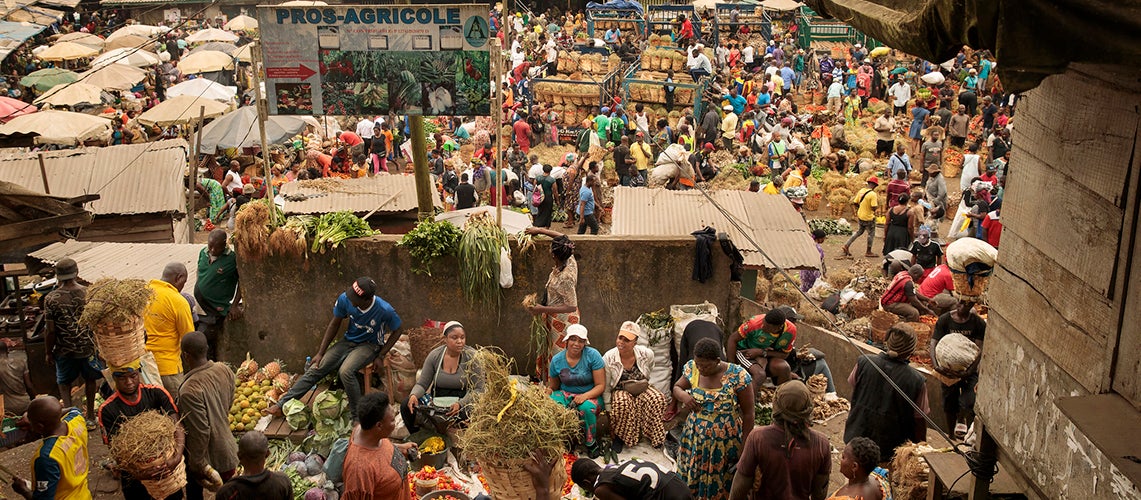 Douala is the economic capital of Cameroon and known for its whole-sale and retail markets. Photo: Ryan Brown/UN Women
Douala is the economic capital of Cameroon and known for its whole-sale and retail markets. Photo: Ryan Brown/UN Women
Low-income countries will have a much harder time putting their economies in the “medically induced coma” of a full lockdown in response to the coronavirus (COVID-19) pandemic. They are home to many of the extreme poor, who, for the most part, have no option but to live in overcrowded conditions with limited access to clean water and sanitation. They work in the informal sector, often for a daily wage, depend heavily on public services, and have limited savings and no access to credit. For many, staying at home is not a viable option, and not working comes at the expense of food and other necessities.
The net benefits are even less clear once we recognize that:
- Lockdowns have had less impact on mobility in LICs, requiring a significant security response.
- Current safety nets have very low coverage in low-income countries, with less than 4% of people covered by a cash transfer program.
- Fiscal outlays just for cash transfers could reach $1.14 trillion globally, most of which would have to be spent in low-income countries on people not already covered by existing safety nets.
- Food systems, already under stress due to a massive locust outbreak, may be severely disrupted.
- A lockdown has severe effects on children’s schooling and risks increasing other illnesses such as tuberculosis.
Consequently, many countries are considering a policy of graded lockdowns or “smart containment,” based on the idea of risk stratification. By restricting mobility for certain groups (the elderly and those with co-morbidities) or in certain geographical areas, governments hope to protect both health and economic activity. One example of geographical lockdowns is Chile’s policy of “dynamic quarantines” where neighborhoods are locked down and reopened as the epidemic moves.
What does smart containment mean for governments?
Smart containment allows economic activity to continue while protecting health , but it also requires a different, more flexible, approach to conceptualizing and implementing policies and programs. In particular, policies will have to be tailored to three phases of the epidemic within local geographies:
- Precautionary Phase: While there are no cases in a community, smart containment requires some degree of physical distancing in agricultural activities and travel, combined with isolation of and income support for vulnerable groups. It also requires some degree of testing to detect early infections.
- Epidemic Phase: If the epidemic takes root in the community, economic activity should be suspended and broad-based cash (and potentially food) distribution put in place.
- Recovery Phase: A gradual reactivation of economic activity and travel, still in compliance with a degree of physical distancing, should be combined with income support to vulnerable groups and the potential use of public works for those without a job.
The key point is that both the design of specific policies and the policy mix will vary across groups and space and over time . This is very different from what governments usually do. Policies and programs normally target specific groups (pensions for the elderly), issues (contractionary monetary policy to control high inflation), or areas (funding for lagging regions). Once these are defined, policy design and implementation remain stable over time, or until a target is achieved (a decline in the inflation rate or the achievement of an inflation target, in the case of monetary policy). In contrast, a smart containment approach enables governments to design, implement and monitor policies and programs that vary across people, places and phases to effectively address the localized and evolving nature of health, social, and economic impacts. This requires tremendous imagination and innovation.
One implication of policy flexibility is that data-driven decisions become critical. For instance:
- Pre-crisis survey and administrative data (e.g., data on households, business, or water and sanitation and health facilities) can be combined with satellite and other geospatial data to identify risk groups and “hotspots” and inform preparatory efforts and initial policy interventions. Areas with high population density and low access to water and sanitation infrastructure may be fertile terrain for rapid contagion and thus require intense monitoring. Similarly, areas with high foot traffic and/or concentration of economic activity may be priorities for imposing physical distancing.
- As the crisis unfolds, the situation on the ground will remain fluid. Combining information from ex-ante risk profiles with high-frequency data on health and socioeconomic indicators will be critical to monitoring efforts, decision making, and program implementation. Mobility restrictions should be imposed and lifted on the basis of health data. Similarly, decisions on design and implementation of cash and/or in-kind support measures (who, where, for how long) should be informed by data on economic impacts, food security, and market disruptions. An early start here is the World Bank’s high-frequency monitoring efforts in a large number of countries.
- Data will also be critical in preparing for recovery, even as governments are still dealing with the immediate impacts of the crisis. High-frequency data on coping strategies, such as the sale of productive assets or the depletion of working capital, and on business closures can provide valuable information about the depth of the economic shock and the amount and nature of stimulus needed. Similarly, data on school attendance, combined with administrative data on school closures and openings, can help minimize dropouts.
Can this be done?
Countries are understandably anxious about COVID-19, and any policy is likely to introduce tremendous hardship for some populations. Graded lockdowns will require governments to tailor policy responses across people, places, and phases as the pandemic moves, with significant investments in administrative capacity, particularly at the local level. But the reality is that full lockdowns — which is the other option on the table — also require enormous effort, albeit of a different nature. The choice between these options — smart containment vs. full lockdowns — is therefore a choice between different administrative capacity investment strategies, rather than between the possible and the impossible.
Faced with this choice, a strategy that combines strong involvement of local governments and community organizations with national efforts to coordinate data-driven responses and fill holes in local capacity to ensure equity will be required, for two reasons. First, many countries are already taking this route, and they will need to manage the significant — and different — health and economic risks that come with this choice. Second, given the uncertain trajectory of the pandemic, low-income countries can significantly benefit from the flexibility of this approach. Even if feasible to shut down their economies repeatedly, it will be hugely costly and potentially harmful for these countries, should the epidemic wax and wane over time. If, on the other hand, the experience of low-income countries is significantly different from that of wealthier countries affected by COVID-19, graded lockdowns may save lives, by reducing morbidity unrelated to COVID-19, more effectively protecting livelihoods and staving off the risk of food insecurity.
A more detailed version of this piece is here.



Join the Conversation